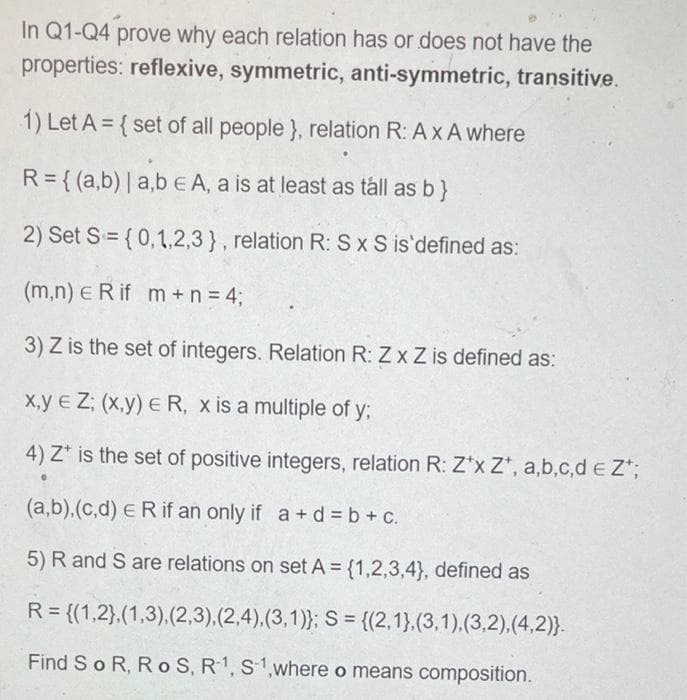In Q1-Q4 prove why each relation has or does not have the properties: reflexive, symmetric, anti-symmetric, transitive. 1) Let A = { set of all people }, relation R: A xA where R = { (a,b) | a,b EA, a is at least as tall as b}
In Q1-Q4 prove why each relation has or does not have the properties: reflexive, symmetric, anti-symmetric, transitive. 1) Let A = { set of all people }, relation R: A xA where R = { (a,b) | a,b EA, a is at least as tall as b}
Elements Of Modern Algebra
8th Edition
ISBN:9781285463230
Author:Gilbert, Linda, Jimmie
Publisher:Gilbert, Linda, Jimmie
Chapter1: Fundamentals
Section1.7: Relations
Problem 14E: In each of the following parts, a relation is defined on the set of all human beings. Determine...
Related questions
Question

Transcribed Image Text:In Q1-Q4 prove why each relation has or does not have the
properties: reflexive, symmetric, anti-symmetric, transitive.
1) Let A = { set of all people }, relation R: A x A where
R= { (a,b) | a,bEA, a is at least as táll as b}
2) Set S = {0,1,2,3}, relation R: Sx S is'defined as:
(m,n) ER if m + n = 4;
3) Z is the set of integers. Relation R: Zx Z is defined as:
x,y e Z; (x,y) E R, x is a multiple of y;
4) Z* is the set of positive integers, relation R: Z*x Z*, a,b,c,de Z*;
(a,b).(c,d) ER if an only if a +d = b + c.
5) R and S are relations on set A = {1,2,3,4}, defined as
R = {(1,2},(1,3),(2,3).(2,4),(3,1)}; S = {(2,1}.(3,1).(3,2).(4,2)}.
Find So R, R o S, R1, S1,where o means composition.
Expert Solution
This question has been solved!
Explore an expertly crafted, step-by-step solution for a thorough understanding of key concepts.
This is a popular solution!
Trending now
This is a popular solution!
Step by step
Solved in 2 steps with 2 images

Recommended textbooks for you

Elements Of Modern Algebra
Algebra
ISBN:
9781285463230
Author:
Gilbert, Linda, Jimmie
Publisher:
Cengage Learning,

Elementary Geometry For College Students, 7e
Geometry
ISBN:
9781337614085
Author:
Alexander, Daniel C.; Koeberlein, Geralyn M.
Publisher:
Cengage,

Elements Of Modern Algebra
Algebra
ISBN:
9781285463230
Author:
Gilbert, Linda, Jimmie
Publisher:
Cengage Learning,

Elementary Geometry For College Students, 7e
Geometry
ISBN:
9781337614085
Author:
Alexander, Daniel C.; Koeberlein, Geralyn M.
Publisher:
Cengage,